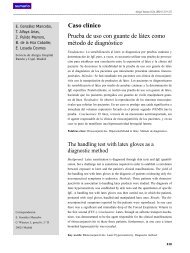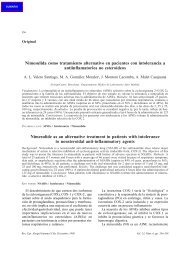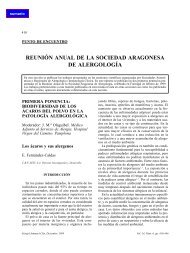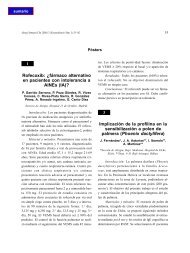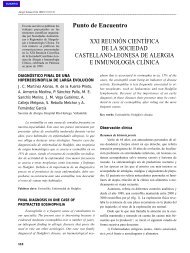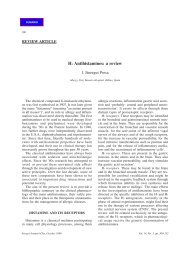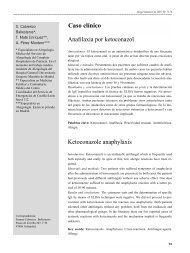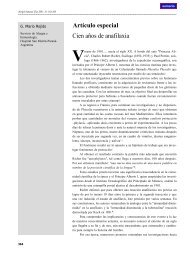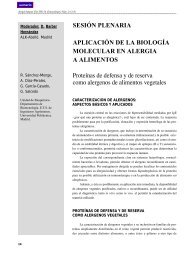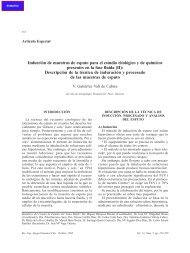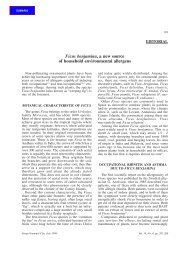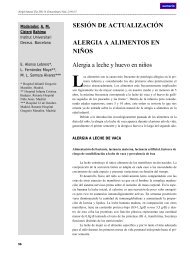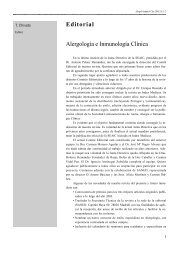Allergy to Anarcadiaceae. Identification of allergens Alergia a ...
Allergy to Anarcadiaceae. Identification of allergens Alergia a ...
Allergy to Anarcadiaceae. Identification of allergens Alergia a ...
Create successful ePaper yourself
Turn your PDF publications into a flip-book with our unique Google optimized e-Paper software.
82<br />
Original article<br />
<strong>Allergy</strong> <strong>to</strong> <strong>Anarcadiaceae</strong>. <strong>Identification</strong> <strong>of</strong> <strong>allergens</strong><br />
E. Funes, J. M. Milán, J. A. Pagán*, J. D. López*, F. J. García*, J. M. Negro*,<br />
J. Hernández*, F. Polo** y P. Rico**<br />
Sección de <strong>Alergia</strong>. Hospital Santa María del Rosell. Cartagena (Murcia). *Sección de <strong>Alergia</strong>. Hospital Universitario Virgen<br />
de la Arrixaca. El Palmar. Murcia. **Labora<strong>to</strong>rio Alk-Abelló. Madrid.<br />
Background: Pistachio, cashew nut, and mango belong <strong>to</strong> the Anacardiaceae family. The increasing consumption <strong>of</strong><br />
these fruits in recent years has determined an increase in the frequency <strong>of</strong> sensitization <strong>to</strong> these foods. Methods: Ten<br />
patients (5 women and 5 men) with his<strong>to</strong>ry <strong>of</strong> food allergy <strong>to</strong> Anacardiaceae were studied by means <strong>of</strong> in vivo and in<br />
vitro techniques. The presence <strong>of</strong> specific IgE against Anacardiaceae was determined by prick test and RAST. The<br />
allergic pr<strong>of</strong>ile <strong>to</strong> pistachio, mango, and cashew nut was assessed by SDS-PAGE followed by immunoblotting. RASTinhibition<br />
test was performed in order <strong>to</strong> evaluate cross-reactivity among members <strong>of</strong> the Anacardiaceae family.<br />
Results: Prick tests against pistachio were positive in 8 patients, against cashew nut in 1, and against mango skin in 7,<br />
mango pulp in 5 and mango seeds in 3. Proteins <strong>of</strong> these products were detected by SDS-PAGE: in pistachio the most<br />
common proteins were found around 14,30,40, and 55 kDa; in cashew nut around 30 and 50 kDa; in mango skin around<br />
10,12,43, and 45 kDa; and in mango pulp five proteins <strong>of</strong> 30, 41, 43, 70 and 80 kDa, respectively, were detected. RASTinhibition<br />
test showed different cross-reactivities among members <strong>of</strong> the Anacardiaceae family and it was observed that<br />
mango seed extract inhibited all other extracts. Conclusions: This study confirms the presence IgE-mediated sensibivity<br />
<strong>to</strong> pistachio, mango, and cashew nut. Different <strong>allergens</strong> in this family were recognized, as well as cross-reactivity<br />
among these <strong>allergens</strong>.<br />
KEY WORDS: Anarcardiaceae <strong>allergens</strong> / Cashew nut / Mango / Pistachio / Cross-reactivity.<br />
<strong>Alergia</strong> a anacardiáceas. Identificación de alergenos<br />
Fundamen<strong>to</strong>: El pistacho, el anacardo y el mango son miembros de la familia Anacardiaceae. El creciente consumo de<br />
es<strong>to</strong>s fru<strong>to</strong>s en los últimos años está llevando a un aumen<strong>to</strong> en la frecuencia de la sensibilización frente a ellos. Mé<strong>to</strong>dos:<br />
Se han estudiado 10 pacientes (5 mujeres y 5 varones), con his<strong>to</strong>ria de hipersensibilidad alimentaria a anacardiáceas,<br />
por medio de técnicas tan<strong>to</strong> in vivo como in vitro. Se determinó la presencia de IgE específica frente a anacardiáceas<br />
por medio de prick test y RAST. Se analizó el perfil alergénico frente a pistacho, mango y anacardo por medio<br />
de SDS-PAGE seguido de immunoblotting. Se realizó RAST-inhibición con el obje<strong>to</strong> de valorar la presencia de reactividad<br />
cruzada entre los miembros de la familia anacardiácea. Resultados: Las pruebas cutáneas frente a pistacho fueron<br />
positivas en 8 pacientes, frente a anacardo en uno, frente a piel de mango en 7, frente a pulpa de mango en 5 y<br />
frente a semilla de mango en 3. Mediante SDS-PAGE se detectaron proteínas de es<strong>to</strong>s produc<strong>to</strong>s: en pistacho, las proteínas<br />
más abundantes se encontraron en <strong>to</strong>rno a 14, 30, 40 y 55 kDa; en anacardo, en <strong>to</strong>rno a 30 y 50 kDa; en piel de<br />
mango, en <strong>to</strong>rno a 10, 12, 43 y 45 kDa, y en pulpa de mango se detectaron cinco proteínas de 30, 41, 43, 70 y 80 kDa.<br />
Por medio de RAST-inhibición se encontraron diferentes reactividades cruzadas entre los miembros de la familia Anacardiaceae<br />
estudiados y se comprobó que el extrac<strong>to</strong> de semilla de mango inhibía a los otros extrac<strong>to</strong>s. Conclusiones:<br />
Se confirma la sensibilización mediada por IgE a pistacho, mango y anacardo. Se han identificado distin<strong>to</strong>s alergenos<br />
de esta familia, así como la reactividad cruzada entre ellos.<br />
PALABRAS CLAVE: Alergenos anacardiáceas / Anacardo / Mango / Pistacho / Reactividad cruzada.<br />
Alergol Inmunol Clin, April 1999 Vol. 14, No. 2, pp. 82-89
No. 2 <strong>Allergy</strong> <strong>to</strong> Anacardiaceae 83<br />
INTRODUCTION<br />
Pistachio (Pistacia vera), cashew nut (Anacardium<br />
occidentalis) and mango (Mangifera indica)<br />
are members <strong>of</strong> the Anacardiaceae family 1 . None<br />
<strong>of</strong> the three is au<strong>to</strong>chthonous in Spain 2 . They are<br />
consumed in rather low proportion in comparison<br />
<strong>to</strong> other nuts such as almonds, peanuts and walnuts,<br />
which <strong>to</strong>gether represent 60% <strong>of</strong> the <strong>to</strong>tal<br />
nut consumption in Spain. In our country, pistachio<br />
is probably the member <strong>of</strong> this family which<br />
is more frequently consumed (10% <strong>of</strong> the <strong>to</strong>tal) 3 .<br />
Its introduction in<strong>to</strong> the Spanish diet is relatively<br />
recent. It is consumed both in the form <strong>of</strong> the<br />
roasted or salted nut and as a component in ice<br />
cream, sweets and other desserts. The consumption<br />
<strong>of</strong> cashew nut and mango is minimal in<br />
Spain; however, their increasing introduction in<strong>to</strong><br />
the market might determine an increase in the frequency<br />
<strong>of</strong> sensitization <strong>to</strong> these products.<br />
Data on food allergy <strong>to</strong> members <strong>of</strong> the Anacardiaceae<br />
family are scarce. Miell et al. 4 in 1988<br />
reported one case <strong>of</strong> anaphylaxis after the ingestion<br />
<strong>of</strong> mango pulp in a fruit vendor. Other au-<br />
Table I. Results <strong>of</strong> the skin tests<br />
thors have reported clinical cases <strong>of</strong> allergic reactions<br />
<strong>to</strong> mango 5-9 . Jansen et al. 5 studied three<br />
patients with adverse reactions <strong>to</strong> pistachio and<br />
mango and demonstrated skin test positivity and<br />
specific serum IgE <strong>to</strong> these fruits. In Spain, Fernández<br />
and Fiandor 10, 11 reported two cases <strong>of</strong> pistachio<br />
anaphylaxis and investigated the <strong>allergens</strong><br />
involved and their cross-reactivity with other Anacardiaceae.<br />
Parra et al. 12 reported (in 1993) three<br />
patients with allergy <strong>to</strong> pistachio and other nuts;<br />
they studied the cross-reactivity between these<br />
nuts and some pollens, and tried <strong>to</strong> identify the<br />
pistachio <strong>allergens</strong>. Malet et al. 13 , in 1994,<br />
detected five allergenic fractions in pistachio by<br />
means <strong>of</strong> SDS-PAGE immunoblotting; the 57.1<br />
and 74.0 kDa allergenic fractions were those that<br />
most frequently bound IgE from the studied sera.<br />
The cashew nut is the seed <strong>of</strong> a nut produced by<br />
an American tropical tree; it is edible, ad is frequently<br />
consumed as a snack. Cashew nut<br />
anaphylaxis was described by Stricker et al. in<br />
1986 14 . Samson et al. 15 reported two cases <strong>of</strong> death<br />
after eating cashew nuts in a series <strong>of</strong> 13 patients<br />
with severe anaphylactic reactions induced by<br />
Case Pneumo<strong>allergens</strong> Tropho<strong>allergens</strong><br />
1 Artemisia, Parietaria, Chenopodium Pistachio, almond hazelnut,<br />
peanut, walnut<br />
2 Artemisia, Parietaria, Chenopodium Pistachio, pine kernels,<br />
grasses, olive sunflowers seeds<br />
3 Artemisia, Parietaria, Chenopodium<br />
grasses, olive<br />
Pistachio<br />
4 Artemisia, Parietaria, Chenopodium, Pistachio, chard, cabbage, spinach,<br />
Derma<strong>to</strong>phagoides pteronyssinus, olive sunflowers seeds, greens beans, banana<br />
5 Artemisia, Parietaria, Chenopodium Pistachio, celery, hazelnut, peanut,<br />
beans, peas, walnut<br />
6 Artemisia, Parietaria, Chenopodium Chestnut, sunflower seeds, grape banana,<br />
almonds, peanuts, hazelnuts, walnuts<br />
7 Parietaria, grasses, olive Almond, hazelnut, peanut, grapes<br />
peaches<br />
8 Artemisia, Parietaria, Chenopodium Pistachio, almond, hazelnut, peanut,<br />
grases, olive chesnut, pine kernels, sunflowers seeds<br />
9 Artemisia, grasses Garlic, almond, hazelnut, chestnut,<br />
sunflowers seeds<br />
10 Artemisia, Parietaria Chenopodium Almond, hazelnut, peanut, date,<br />
grasses, olive walnut, sunflower seeds, pine kernels
84 E. Funes, et al. Volume 14<br />
foods. Hernández et al. 16 described the coincidence<br />
<strong>of</strong> pollinosis and allergic reactions <strong>to</strong> fruits and<br />
leaf vegetables. Further authors 8, 17, 18 have studied<br />
the association <strong>of</strong> pollinosis and Anacardiaceae<br />
allergy. There have been studies on allergic sensitization<br />
<strong>to</strong> cashew pollen 19 , as well as on the possible<br />
cross-reactivity between its antigens and<br />
other pollens 20 .<br />
Although there are few studies <strong>of</strong> anaphylactictype<br />
reactions induced by physical exercise in<br />
relation <strong>to</strong> the ingestion <strong>of</strong> Anacardiaceae 21, 22 , there<br />
can be no doubt that such reactions will be<br />
reported in increasing numbers with the passage<br />
<strong>of</strong> time.<br />
Mango is one <strong>of</strong> the tropical fruits which has<br />
been known for the longest time. The green fruits<br />
are prepared as preserves and are used in the preparation<br />
<strong>of</strong> jams, jellies and syrups. They are also<br />
used as aromas in bakery, ice cream and meat products.<br />
An oil is obtained from the seed. Mango is<br />
also used as a dentifrice because <strong>of</strong> its potent<br />
enzymatic power, and for the treatment <strong>of</strong> diarrhoea.<br />
It is a fruit with a high protein content<br />
which may give it a great allergenic potency.<br />
Besides these three, other plants belonging <strong>to</strong><br />
this botanical family are poison ivy, poison oak,<br />
poison sumac and the Japanese or lacquer sumac,<br />
and cell-mediated allergic reactions <strong>to</strong> these species<br />
have been reported.<br />
The aim <strong>of</strong> the present study was <strong>to</strong> confirm the<br />
presence <strong>of</strong> IgE-mediated sensitization <strong>to</strong> pistachio,<br />
cashew nut and mango, <strong>to</strong> identify a number<br />
<strong>of</strong> common <strong>allergens</strong>, and <strong>to</strong> demonstrate crossreactivity<br />
between these fruits.<br />
PATIENTS AND METHODS<br />
Patients. Ten patients were studied, five males<br />
and five females, with ages ranging between 16<br />
and 40 years, with reported clinical his<strong>to</strong>ries suggestive<br />
<strong>of</strong> hypersensitivity reactions <strong>to</strong> pistachio.<br />
All ten patients had a previous his<strong>to</strong>ry <strong>of</strong> pollen<br />
rhinitis/asthma, in nine cases with positive prick<br />
tests with Parietaria and in nine with Artemisia<br />
(ragweed). Nine <strong>of</strong> the patients had antecedents <strong>of</strong><br />
fruit or nut sensitisation. As for the clinical symp<strong>to</strong>ms<br />
<strong>of</strong> pistachio hypersensitivity, six patients<br />
reported an oral allergy syndrome (OAS), consisting<br />
<strong>of</strong> pruritus and more or less important oede-<br />
ma <strong>of</strong> the lips and oral mucosa; two patients had<br />
had OAS with subsequent urticaria-angioedema,<br />
and the other two urticaria-angioedema alone, in<br />
one case with glottic involvement. Ten control<br />
subjects were included in the study, <strong>of</strong> which five<br />
were a<strong>to</strong>pic and five non-a<strong>to</strong>pic. Table I summarises<br />
the positive prick tests with airborne <strong>allergens</strong><br />
and foodstuffs which the patients presented in<br />
their past his<strong>to</strong>ries.<br />
Skin tests. The skin tests were performed using<br />
the prick by prick technique with fresh extracts <strong>of</strong><br />
mango pulp and skin. Fluid pastes were prepared<br />
with pistachio, cashew nut and mango seeds, and<br />
the skin tests were performed using the same technique.<br />
At the same time, prick tests were performed<br />
with a conventional series <strong>of</strong> inhalant <strong>allergens</strong><br />
including pollens <strong>of</strong> five grasses, Olea<br />
europaea, Artemisia vulgaris, Chenopodium spp.<br />
and Parietaria judaica, mites (Derma<strong>to</strong>phagoides<br />
pteronyssinus and D. farinae), moulds (Alternaria<br />
tenuis, Aspergillus spp. and Cladosporium), and<br />
epithelia (rabbit, cat and dog), all commercially<br />
acquired from Dome/Hollister-Stier. The skin<br />
tests were performed on the volar aspect <strong>of</strong> the<br />
forearm with Hollister-Stier lancets (Prick Lancetter).<br />
The results were read after 15 minutes. The<br />
reactions were compared with those induced by<br />
10 mg/ml histamine hydrochloride. The reactions<br />
<strong>to</strong> the <strong>allergens</strong> were considered positive when the<br />
diameter <strong>of</strong> the elicited wheal was equal <strong>to</strong> or greater<br />
than 3 mm. In all the skin tests, negative control<br />
tests with normal saline were included.<br />
Extract preparation. Extracts were prepared<br />
from pistachio, cashew nut and mango seed, epicarpium<br />
(skin) and mesocarpium (pulp). Prior <strong>to</strong><br />
extraction, the pistachio, cashew and mango seeds<br />
were defatted with ethyl ether in a Soxhlet apparatus.<br />
The Bjorkstén buffer 23 with added enzyme<br />
inhibi<strong>to</strong>rs was used for the extractions.<br />
The extractions were carried out through homogenisation<br />
<strong>of</strong> the raw materials with the buffer (at<br />
1:1 weight/volume ratio in the case <strong>of</strong> the mango<br />
seed, pulp and skin, and at 1:2 ratio for the pistachio<br />
and the cashew nut), followed by centrifugation<br />
at 20,000 g for 30 minutes at ambient temperature.<br />
The supernatants were filtered through 0.2<br />
µm filters and dialysed for 20 hours at 4 o C against<br />
10 mM phosphate buffer (pH 7.0) with 3 mM<br />
NaN 3 . Finally, the extracts were again filtered<br />
through 0.2 µm filters and then divided in<strong>to</strong> ali-
No. 2 <strong>Allergy</strong> <strong>to</strong> Anacardiaceae 85<br />
Table II. Sera pools, according <strong>to</strong> their specificities<br />
Pool Sera Specifity (RAST class ≥2)<br />
A 2,3 Pistachio, cashew<br />
B 4,6,10 Mango skin, mango pulp, pistachio,<br />
cashew<br />
C 1,8,9 Mango skin<br />
D 4,10 Mango pulp, mango skin, pistachio,<br />
cashew<br />
Pools “B” and “D” differ only in the exclusion <strong>of</strong> serum No. 6<br />
(RAST class 0 <strong>to</strong> mango pulp) from the latter, which was used<br />
exclusively for the immunodetection <strong>of</strong> mango pulp extract.<br />
quots and kept at -20 o C until the time <strong>of</strong> use. For<br />
some techniques, for which the required protein<br />
concentrations were higher than those in the<br />
extracts, one aliquot <strong>of</strong> the extract was dialysed<br />
against water and then lyophilised. The quantity<br />
<strong>of</strong> protein present in the extracts was assessed by<br />
the method described by Smith et al. 24 , with<br />
results <strong>of</strong> 19.76 mg/ml for pistachio, 13.14 mg/ml<br />
for cashew nut, 0.68 mg/ml for mango skin, 1.28<br />
mg/ml for mango pulp, and 1.06 mg/ml for mango<br />
seed.<br />
For the sensitization <strong>of</strong> cellulose discs, the<br />
extracts were brought <strong>to</strong> a 1 mg/ml concentration<br />
with phosphate buffer (PO 4 H 2 Na 0.2 M, PO 4 HNa 2<br />
0.2 M, NaCl 0.15 M; pH 8.0), and incubated with<br />
CNBr 25 -activated discs (40 ml extract solution per<br />
g <strong>of</strong> disc) for 16 hours at 4 o C and under agitation.<br />
The discs were then washed with the same buffer,<br />
40 ml Tris-HCl 0.1 M buffer (pH 8.0) were added<br />
Table III. Skin test and RAST results with Anacardiaceae<br />
and the discs were again incubated for 1 hour at<br />
ambient temperature under agitation. Finally, the<br />
discs were washed with a Tween 20 solution<br />
(0.05% v/v) in PBS and conserved in phosphate<br />
buffer, pH 8.0, at 4 o C until used.<br />
Direct RAST. For the assessment <strong>of</strong> specific IgE<br />
<strong>to</strong> pistachio, cashew nut and mango (skin, pulp<br />
and seed), the method described by De Filippi et<br />
al. 26 was essentially followed. Discs sensitized<br />
with Lolium perenne and a calibrated serum for<br />
this grass were used as controls. The results were<br />
expressed as RAST classes.<br />
SDS-PAGE and immunoblotting. These techniques<br />
were used for analysing the pistachio, cashew<br />
and mango skin and pulp extracts. The mango<br />
seed extract was not included in the analyses as<br />
no adequate serum was available (according <strong>to</strong> the<br />
RAST results) for the immunodetection <strong>of</strong> its<br />
allergenic proteins. The sera from the patients<br />
were pooled according <strong>to</strong> their specificities as<br />
defined by the RAST results. Table II shows the<br />
sera contained in each pool.<br />
The proteins were separated by polyacrylamide<br />
gel electrophoresis in the presence <strong>of</strong> sodium<br />
dodecylsulfate (SDS-PAGE), following the method<br />
described by Fling and Gregerson 27 with a 8<strong>to</strong>-25%<br />
acrylamide gradient. After separation, the<br />
proteins were transferred <strong>to</strong> PVDF membranes<br />
(Immobilon-P, Millipore) according <strong>to</strong> the method<br />
<strong>of</strong> Towbin 28 . After blocking the active sites in the<br />
membranes with 1% bovine serum albumin<br />
(BSA) in PBS, the membranes were incubated<br />
Pistachio Cashew Mango<br />
Case Skin Pulp Seed<br />
PT RAST PT RAST PT RAST PT RAST PT RAST<br />
1 9 1 0 0 10 2 8 0 0 0<br />
2 6 2 4 2 10 1 10 0 4 0<br />
3 10 2 0 1 0 0 5 0 0 0<br />
4 5 2 0 1 0 3 0 2 0 0<br />
5 0 0 0 0 5 0 5 0 0 0<br />
6 5 2 0 2 0 3 0 0 5 0<br />
7 6 0 0 0 10 0 0 0 0 0<br />
8 7 0 0 0 6 3 0 0 0 0<br />
9 0 1 0 0 6 3 0 0 0 0<br />
10 6 3 0 2 6 3 6 2 8 1<br />
PT = prick test wheal diameter (mm); RAST class.
86 E. Funes, et al. Volume 14<br />
overnight at room temperature with the patient<br />
sera, diluted 1:3 in PBS containing 1% BSA and<br />
0.05 Tween 20. The membranes were then washed<br />
with PBS-Tween 20 and then incubated overnight<br />
at room temperature with 125 I-labelled HE2 monoclonal<br />
mouse anti-human IgE antibody 29 . Finally,<br />
the membranes were again washed with PBS-<br />
Tween, dried, and au<strong>to</strong>radiographed.<br />
RAST inhibition. This technique was used for<br />
the study <strong>of</strong> cross-reactivity between pistachio<br />
and other Anacardiaceae. The procedure described<br />
by Yman et al. 30 was followed, using discs<br />
sensitised with pistachio, cashew and mango skin<br />
and pulp extracts as the solid phases and the same<br />
extracts and that <strong>of</strong> mango seed as inhibi<strong>to</strong>rs. The<br />
tests were carried out with the “B” sera pool (specificity,<br />
RAST class ≥2 for mango skin and pulp,<br />
pistachio and cashew), so as <strong>to</strong> have available the<br />
most ample possible representation <strong>of</strong> the various<br />
IgE specificities.<br />
A first incubation was carried out with 25 µl <strong>of</strong><br />
the sera pool and 25 µl <strong>of</strong> the 2 mg/ml inhibiting<br />
extracts (except for the mango seed extract, which<br />
was tested at 40 mg/ml concentration) for 30 min<br />
at 37 o C. The same extract coupled <strong>to</strong> the disc at 1<br />
mg/ml concentration was used as maximum inhibition<br />
control, and 1% BSA as the 0% inhibition<br />
control. One extract-sensitised cellulose disc was<br />
then added <strong>to</strong> each well and incubated for three<br />
hours at 37 o C. After three washings with PBS-<br />
Tween, the discs were incubated overnight at<br />
room temperature with 50 µl <strong>of</strong> a 125 I-labelled<br />
mouse anti-human IgE monoclonal antibody. The<br />
discs were finally washed thrice with PBS-Tween<br />
and then counted in a Gamma-counter.<br />
RESULTS<br />
Skin tests and RAST. Table III shows the results<br />
<strong>of</strong> the skin tests with the studied members <strong>of</strong> the<br />
Anacardiaceae family. Eight patients had positive<br />
prick tests <strong>to</strong> natural pistachio and only one <strong>to</strong><br />
cashew. As for mango, seven patients had positive<br />
tests with mango skin, five had positive tests <strong>to</strong><br />
mango pulp, and three had positive tests <strong>to</strong> mango<br />
seed. None <strong>of</strong> the ten control subjects had positive<br />
tests with the Anacardiaceae extracts. Nine<br />
patients had positive prick tests with Artemisia<br />
and Parietaria, and six had positive tests <strong>to</strong> grass<br />
file: E:\Alta_2\SANED 1999\alergia<br />
Fig. 1. Electrophoretic patterns <strong>of</strong> the extracts. The left-hand<br />
colum indicates the molecular weights <strong>of</strong> the proteins included<br />
as markers in the same gel: lysozyme (14,4 kDa), soybean<br />
trypsin inhibi<strong>to</strong>r (21.5 kDa), carbonic anhydrase (31.0<br />
kDa), ovoalbumin (45.0 kDa), bovine serum albuminm (66.2<br />
kDa) and b-phosphorylase (92.5 kDa). The following<br />
amounts <strong>of</strong> protein were loaded on<strong>to</strong> each lane: pistachio (P),<br />
125 µg; cashew (A), 125 µg; mango epicarpium (ME),<br />
350 µg; mango mesocarpium (MM), 250 µg. The proteins<br />
were stained with Coomassie blue.<br />
and olive pollens. Only one patient had positive<br />
skin prick tests with non-pollen <strong>allergens</strong>, in this<br />
case Derma<strong>to</strong>phagoides pteronyssinus.<br />
The RAST results (expressed as RAST classes)<br />
are shown in Table III. Positive specific IgE<br />
(RAST class ≥2) <strong>to</strong> pistachio was present in five<br />
patients, <strong>to</strong> cashew in three, <strong>to</strong> mango skin in six<br />
and <strong>to</strong> mango pulp in two; there was only one<br />
class 1 RAST <strong>to</strong> mango seed.<br />
SDS-PAGE. The results are shown in Figure 1.<br />
Proteins were detected in the 10 - 100 kDa range<br />
in all the extracts. In the case <strong>of</strong> pistachio and cashew,<br />
the most abundant proteins are found about<br />
the 15, 35 and 50 kDa levels; in mango epicarpium<br />
there is a more abundant protein with a<br />
molecular weight <strong>of</strong> ca. 24 kDa, and in mango<br />
mesocarpium there are three proteins with molecular<br />
weights <strong>of</strong> about 10, 18 and 26 kDa.<br />
Immunoblotting. The results are shown in Figure<br />
2. Generally, it was seen that immunodetection<br />
with sera pools with more restricted specificity<br />
revealed a lesser number <strong>of</strong> bands. Thus, the pistachio<br />
extract (P) incubated with pool “A” only
No. 2 <strong>Allergy</strong> <strong>to</strong> Anacardiaceae 87<br />
fil \ l \ \ l i<br />
Fig. 2. Immunodetection <strong>of</strong> the allergenic proteins in the<br />
pistachio (P), cashew (A), mango epicarpium (ME) and<br />
mango mesocarpium (MM) extracts. On the left are the MW<br />
values <strong>of</strong> the proteins included as markers in the same gel.<br />
The letters below the gel indicate the pools <strong>of</strong> patient sera<br />
used.<br />
revealed two bands, with molecular weights <strong>of</strong> 30<br />
kDa (the strongest one) and 14 kDa (weak), while<br />
incubation with the “B” pool revealed, besides<br />
these bands, further ones <strong>of</strong> medium intensity between<br />
40 and 55 kDa. The same was seen with the<br />
cashew extract (A): two bands <strong>of</strong> 29 and 50 kDa<br />
MW with pool “A”, and further bands with pool<br />
“B”. In the case <strong>of</strong> the mango skin extract (ME),<br />
incubation with pool “C”, which was specific for<br />
this extract, yielded only two low MW bands (≈<br />
10 and 12 kDa), while pool “B” detected a great<br />
number <strong>of</strong> bands, some <strong>of</strong> them very intense at 43<br />
and 45 kDa. In the mango pulp extract five very<br />
intense bands were detected, corresponding <strong>to</strong><br />
proteins with 9, 41, 43, 70 and 80 kDa MW, besides<br />
some weaker ones, when pool “D” was used.<br />
No sera specific only for this extract were available.<br />
RAST inhibition. Table IV shows the inhibition<br />
values achieved with each <strong>of</strong> the extracts<br />
used as inhibi<strong>to</strong>rs, for each <strong>of</strong> the solid phases<br />
used. It should be pointed out that these values<br />
might in some instances entail considerable<br />
imprecissions, as the differences in c.p.m. between<br />
the 0% and 100% values are very small<br />
due <strong>to</strong> the low levels <strong>of</strong> specific IgE in the sera<br />
pools used.<br />
Table IV. RAST inhibition results<br />
Inhibi<strong>to</strong>r Pistachio Cashew Mango<br />
Skin Pulp Seed<br />
Solid phase<br />
Pistachio 100 51 97 53 85<br />
Cashew 56 100 100 100 89<br />
Mango skin 35 20 100 34 34<br />
Mango pulp 32 40 80 100 76<br />
Results expressed as % inhibition.<br />
DISCUSSION<br />
Despite the low rate <strong>of</strong> consumption <strong>of</strong> members<br />
<strong>of</strong> the Anacardiaceae family as compared <strong>to</strong><br />
other nuts 3 , their increasing consumption is leading<br />
<strong>to</strong> a similar increase in the frequency <strong>of</strong> sensitization.<br />
They sometimes cause severe clinical<br />
problems (anaphylaxis, glottis oedema), so that<br />
many authors recommend that these foodstuff be<br />
included in the list <strong>of</strong> “foods <strong>to</strong> be considered” in<br />
the study <strong>of</strong> idiopathic anaphylactic reactions.<br />
Furthermore, we should not forget the cellular<br />
immunity-mediated allergic reactions <strong>to</strong> members<br />
<strong>of</strong> this botanical family, such as contact dermatitis<br />
<strong>to</strong> poison ivy, poison oak, cashew or mango.<br />
The present study confirms, as already done by<br />
other authors, the existence <strong>of</strong> type I hypersensitivity<br />
reactions <strong>to</strong> members <strong>of</strong> the Anacardiaceae<br />
family, both by prick test and by the presence <strong>of</strong><br />
specific IgE <strong>to</strong> pistachio, cashew and mango in<br />
the patients’ sera. The agreement between the skin<br />
tests with members <strong>of</strong> the Anacardiaceae family<br />
and the RAST results in the present study is<br />
moderate, as already pointed out in other studies<br />
with this type <strong>of</strong> fruits 16 .<br />
By means <strong>of</strong> immunoblotting it was shown that<br />
the various pools <strong>of</strong> patient sera recognised<br />
various proteins in pistachio, cashew and mango.<br />
Generally, it was observed that immunodetection<br />
with the pools evidencing more restricted specificity<br />
disclosed a smaller number <strong>of</strong> bands. As in<br />
other previous studies 11, 12 , the presence <strong>of</strong> a very<br />
intense band <strong>of</strong> 30 kDa MW was demonstrated,<br />
which could represent the major allergen <strong>of</strong> pistachio.<br />
Our results appear <strong>to</strong> confirm the existence <strong>of</strong>
88 E. Funes, et al. Volume 14<br />
cross-reactivity between the various members <strong>of</strong><br />
the family. Firstly, there are the prick test results<br />
in patients with pistachio allergy, who evidence<br />
positive skin tests <strong>to</strong> other members <strong>of</strong> the family<br />
without the patients having ever eaten cashew or<br />
mango. Secondly, the results <strong>of</strong> RAST inhibition 11<br />
demonstrate the existence <strong>of</strong> an important allergenic<br />
community between the various members <strong>of</strong><br />
the Anacardiaceae family. However, this marked<br />
cross-reactivity is not always clinically important,<br />
and further studies are required in order <strong>to</strong> achieve<br />
absolute confirmation <strong>of</strong> the cross-reactivity<br />
between pistachio, cashew and mango.<br />
All the patients studied evidenced also seasonal<br />
rhinoconjunctivitis, in some cases in association<br />
<strong>to</strong> pollinic bronchial asthma, an association which<br />
has been described previously 8, 16-18 . Artemisia vulgaris<br />
was positive in nine patients, so that the<br />
prick test positivity <strong>to</strong> this pollen might be a<br />
valuable orientative datum <strong>of</strong> a possible food<br />
allergy aetiology as responsible for a given allergic<br />
picture 16 . The tests with Parietaria pollen were<br />
also positive in nine patients, an observation that<br />
might be explained through a certain degree <strong>of</strong><br />
cross-reactivity with the Anacardiaceae, as<br />
demonstrated in several studies 18 . Besides, nine <strong>of</strong><br />
the patients were also sensitised <strong>to</strong> fruits or nuts,<br />
suggesting that common antigenic determinants<br />
are shared with pollens and vegetable foodstuffs.<br />
Although the overall consumption <strong>of</strong> mango,<br />
pistachio and cashew is low in Spain, as compared<br />
<strong>to</strong> other fruits and nuts, we deem it advisable<br />
<strong>to</strong> point out that these fruits may cause IgEmediated<br />
allergic sensitization. The triggered clinical<br />
symp<strong>to</strong>ms may be severe. In the case <strong>of</strong> sensitization<br />
<strong>to</strong> one <strong>of</strong> these products, it is advisable<br />
<strong>to</strong> avoid all the other members <strong>of</strong> the Anacardiaceae<br />
family, because <strong>of</strong> the possibility <strong>of</strong> crossreactivity<br />
between them.<br />
REFERENCES<br />
1. Mabberly DJ. The plant-book. A portable dictionary<br />
<strong>of</strong> the higher plants. Cambridge: Cambridge<br />
University Press, 1987; 27: 354-458.<br />
2. Font Quer P. Anacardiáceas. En: Font Quer P, ed.<br />
Plantas medicinales. El Dioscórides renovado. Barcelona.<br />
Edi<strong>to</strong>rial Labor SA, 1990; 440-445.<br />
3. Secretaría técnica. Fru<strong>to</strong>s secos. En: Ministerio de<br />
Agricultura, Pesca y Alimentación. Dirección gene-<br />
ral de política alimentaria, ed. Consumo alimentario<br />
en España 1990. Madrid. Gráficas Monterreina<br />
SA, 1991; 1491-1515.<br />
4. Miell J, Papouchado M, Marshall AJ. Anaphylactic<br />
reaction after eating a mango. BMJ 1988; 297:<br />
1639-1640.<br />
5. Jansen A, Lijster J, Toorenenberger A, van Wijk R.<br />
<strong>Allergy</strong> <strong>to</strong> pistachio nuts. <strong>Allergy</strong> Proc 1992; 13:<br />
255-258.<br />
6. Dang R, Bell D. Anaphylactic reaction <strong>to</strong> the ingestion<br />
<strong>of</strong> mango. Hawaii Med J 1967; 27: 149-150.<br />
7. Rubin JM, Shapiro J, Muehlbauer P, Grolnnick M.<br />
Shock reaction following ingestion <strong>of</strong> mango.<br />
JAMA 1965; 193: 391-398.<br />
8. Wüthrich B, H<strong>of</strong>er T. Food allergy: the celery-mugwort-spice<br />
syndrome associated with mango<br />
allergy? Dtsch Med Wochenschr 1984; 109: 981-<br />
986.<br />
9. Armentia A, Sanchis E, Méndez J, Fru<strong>to</strong>s J, De la<br />
Fuente R, Sánchez P, et al. Anafilaxia por ingesta<br />
de mango. Rev Esp Alergol Inmunol Clín 1994; 9:<br />
219-222.<br />
10. Fernández C, Fiandor A, Martínez A, Martínez J.<br />
Anafilaxia por pistacho, presentación de dos casos<br />
y detección de alergenos. Rev Esp Alergol Inmunol<br />
Clín 1992; 7: 105.<br />
11. Fernández C, Fiandor A, Martínez-Garate A, Martínez<br />
Quesada J. <strong>Allergy</strong> <strong>to</strong> pistachio: crossreactivity<br />
between pistachio nut and other anacardiaceae.<br />
Clin Exp <strong>Allergy</strong> 1995; 25: 1254-1259.<br />
12. Parra FM, Cuevas M, Lezaum A, Alonso MD,<br />
Beristain AM, Losada E. Pistachio nut hypersensitivity:<br />
identificatión <strong>of</strong> pistachio nut <strong>allergens</strong>. Clin<br />
Exp <strong>Allergy</strong> 1993; 23: 996-1001.<br />
13. Malet A, Amat P, Lluch M, Serra E, Valero A.<br />
Hipersensibilidad al pistacho: estudio de las fracciones<br />
alergénicas (resumen). Rev Esp Alergol<br />
Inmunol Clín 1994; 9 ( supl 1): 69.<br />
14. Stricker WE, Anorve López E, Reed CE. Food skin<br />
testing in patients with idiopathic anaphylaxis. J<br />
<strong>Allergy</strong> Clin Immunol 1986; 77: 516-519.<br />
15. Sampson HA, Mendelson L, Rosen JP. Fatal and<br />
near-fatal anaphylactic reactions <strong>to</strong> food in children<br />
and adolescent. N Engl J Med 1992; 347:<br />
380-384.<br />
16. Hernández J, García Sellés FJ, Pagán JA, Negro<br />
JM. Hipersensibilidad inmediata a frutas, verduras<br />
y polinosis. Allergol Immunopathol 1985; 13:197.<br />
17. García Ortiz JC, Cosmes PM, López-Asunsolo A.<br />
<strong>Allergy</strong> <strong>to</strong> foods in patients monosensitized <strong>to</strong> artemisia<br />
pollen. <strong>Allergy</strong> 1996; 51: 927-931.<br />
18. Liccardi G, Mistrello G, Noschese P, Falagiani P,<br />
D’ama<strong>to</strong> G. Oral allergy syndrome (OAS) in pollinosis<br />
patients after eating pistachio nuts: two cases
No. 2 <strong>Allergy</strong> <strong>to</strong> Anacardiaceae 89<br />
with two different patterns <strong>of</strong> onset. <strong>Allergy</strong> 1996;<br />
51: 919-922.<br />
19. Hernández J, Negro JM, García Sellés FJ, Pagán JA,<br />
López JD, Soriano V, et al. Urticaria y angioedema<br />
por ejercicio, dependientes de la ingestión de alimen<strong>to</strong>s.<br />
Rev Esp Alergol Inmunol Clín 1992; 7: 9-17.<br />
20. Hernández García J. Anafilaxia inducida por ejercicio.<br />
Rev Esp Alergol Inmunol Clín 1996; 11<br />
(extraordinario 2): 82-94.<br />
21. Fernández L, Mesquita AM. Anacardium occidentale<br />
cashew: pollen allergy in patients with allergic<br />
bronchial asthma. J <strong>Allergy</strong> Clin Immunol 1995;<br />
95: 501-504.<br />
22. Vargas JB, Sánchez Solis L, Farfán JA. Estudio<br />
alergológico del polen del mango (mangifera indica)<br />
y su reactividad cruzada con el polen de pirú<br />
(schinus molle). Rev Alergol Mexicana 1981; 38:<br />
134-138.<br />
23. Bjorkstén F, Halmeporu L, Hannuksela M, Lahti A.<br />
Extraction and properties <strong>of</strong> apple <strong>allergens</strong>.<br />
<strong>Allergy</strong> 1980; 35: 671-677.<br />
24. Smith PK, Krohn RI, Hermanson GT, Mallia AK,<br />
Gartner FH, Provenzano MD, et al. Measurement<br />
Emilio Funes Vera<br />
C/ Juan de Toledo, 9<br />
30800 Lorca<br />
Murcia, Spain<br />
<strong>of</strong> protein using bicinchonimic acid. Anal Biochem<br />
1985; 150: 76-85.<br />
25. Ceska M, Eriksson R, Varga JM. Radio immunosorbent<br />
assay <strong>of</strong> <strong>allergens</strong>. J <strong>Allergy</strong> Clin Immunol<br />
1981; 49: 1-9.<br />
26. De Filippi I, Yman L, Schroder H. Clinical accuracy<br />
<strong>of</strong> Updated version <strong>of</strong> Phadebas RAST test.<br />
Ann <strong>Allergy</strong> 1981; 46: 249-255.<br />
27. Fling SP, Gregerson DS. Peptide and protein molecular<br />
weight determination by electrophoresis using<br />
a high-molarity Tris buffer system without urea.<br />
Anal Biochem 1986; 155: 83-88.<br />
28. Towbin H, Staehlin T, Gordon J. Electrophoretic<br />
transfer <strong>of</strong> proteins from polyacrylamide gels <strong>to</strong><br />
nitrocellulose sheets: procedure and some applications.<br />
Proc Natl Acad Sci USA 1979; 76: 4350-<br />
4354.<br />
29. Sánchez-Madrid F, Morago G, Corbí AL, Carreira J.<br />
Monoclonal antibodies <strong>to</strong> three distinct epi<strong>to</strong>pes on<br />
human IgE: their use for determination <strong>of</strong> <strong>allergens</strong>specific<br />
IgE. J Immun Meth 1984; 73: 367-378.<br />
30. Yman L, Ponterius G, Brandt R. RAST-based allergen<br />
assay methods. Dev Biol Std 1975; 29: 151-165.




